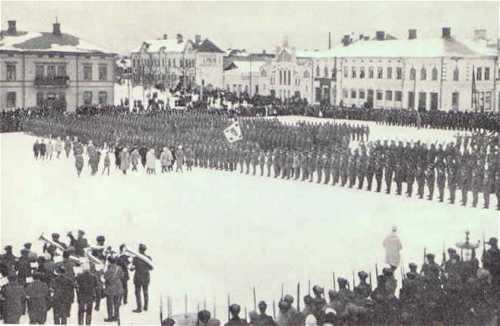


The bulk of the Jägers arrived in Vaasa on the 25th of January. Their reception in Finland was jubilant. When addressing the Jäger Battallion on the marketplace of Vaasa, General Mannerheim referred to their forth-coming mission with the following words, "The young Finnish army, which is still being formed, will regard you as their instructors and future leaders. A great and glorious task is awaiting you: the creation of an army which will be able to liberate Finland and make it great and mighty."
To the great disappointment of the Jägers, it became evident that the headquarters was not intending to employ their skill and knowledge in the way they had planned. They would be dispersed to act as trainers in the 27 regular battallions to be established in various parts of the country. There were also plans to position in those battallions officers who had voluntarily joined the Russian army and who, from the Jägers’ point of view, were traitors. A serious conflict arose. Jäger officers of higher rank assembled in Vaasa on the first of March and decided not to make any compromises over their own plans. There was no sense in waiting until the conscripts were trained, as the attack of the Jäger brigade could put a rapid end to the battle.
That this kind of controversial situation could arise seems mainly to have been due to weaknesses in the flow of information. The question of organization was only part of a larger problem field. It was becoming evident that there would be no rapid end to the war. The Jägers’ idea, on the other hand, was to break the resistance of the reds immediately by strong attacks. They did not trust the "old gentlemen" of the headquarters. There were rumours that Mannerheim attempted to block the advancement of the Jägers in the Finnish army.
Owing to fervent requests by the Senate, the Commander-in-Chief consented to allow the Jäger representatives to state their viewpoint. He decided to put his own plan into action, but in accordance with the organizational model of the Jägers. The officers of the so-called Russian school would be placed in the six recruited grenadier battallions, and the Jägers as trainers in the army of conscripts.
Three Jäger majors, Erik Jernström, Ero Gadolin and Erik Heinrichs came to discuss the matter with Mannerheim. When presenting their demands to the commander, they specifically explained why they did not wish to be posted in the same troops with the officers who had formerly served in Russia. Mannerheim remarked that he himself was in exactly the same position as the officers whom the Jägers considered strangers. He went on stating that he had no intention of interfering in their anti-disciplinary manner of action, but he considered himself a better judge of estimating the situation than those who had not been present. But he also admitted he understood that "a thousand hotheads" had difficulties in giving up their dreams. Therefore, he said that he accepted the Jägers’ plan in an adapted form.
The compromise was gradually carried out through separate orders, and dissatisfaction among the Jägers abated as they dispersed into their troops. To deal with the Jäger matter, a special section was set up in the office of the director of the headquarters and Major Jernström was appointed its head for the time being. The Jägers were allowed to add the word Jäger in their military ranks. The Commander-in-Chief appointed a Jäger, Captain K.H. Kekoni, his ADC, and in late April Jäger Captain Zilliacus and Jäger Lieutenant Paloheimo were given posts in the operative department of the headquarters. Also in May, when steps were taken to plan the new Finnish army, both Mannerheim and the Senate took the opinions of the Jägers into account.
Commander-in-Chief 1918 | Headquarters 1918
| Vaasa Senate | Hannes Ignatius
| Martin Wetzer | Harald Hjalmarson
| Ernst Linder | Gösta Theslöf | Jägers | St Petersburg Question | Relations with Germany | Cross of Liberty
| Eastern Karelia | Uusimaa Dragoon
Regiment | Fir Twig | Finnish Flag
| Swedish Brigade | Civil Guards | Jäger Conflict | Heikki Kekoni | Red Prisoners | Wilhelm Thesleff
| Aarne Sihvo | Rudolf Walden |
Air Force - Air Weapon | Red and White
Terrorism | Great Parade 16 May, 1918 | Åland Question | Monarchy | Mannerheim's Resignation
COURSE OF LIFE | FAMILY | TIME OF GROWTH | MILITARY CAREER | WAR OF INDEPENDENCE | REGENT 1918-1919 | CIVILIAN | DEFENCE COUNCIL | COMMANDER-IN-CHIEF 1939-1946 | PRESIDENT OF THE REPUBLIC 1944-1946 | RETIREMENT | SPECIAL TOPICS | SEARCH